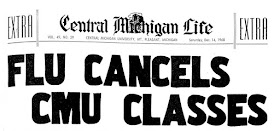The current COVID-19 pandemic is not the first time the educational mission of CMU has been disrupted by disease. Some alumni will remember this headline printed fifty-two years ago in Central Michigan Life (then the name for CM Life) on December 14, 1968:
With over 1,000 cases of the flu reported in residence halls, where there were 6,000 beds available for students, President William Boyd cancelled all classes for three weeks between December 14, 1968 and January 5, 1969. In a world before the internet, students probably took some comfort in President Boyd’s statement that there was no plan to make up missed classes. The President implied, although did not quite say, that no makeup work would be required nor would students be accountable for any missed tests. Students were simply encouraged to leave campus the week before winter break began and stay home until January 6.
It may have been a public health emergency in the president’s eyes, but some students took it less seriously. A picture of smiling students packing a car to go home, published in the same issue, was captioned, “Students wasted no time in leaving for the early Christmas vacation tonight.” And students, thinking about their finances, asked if they left campus early would they be able to get a refund on the unused portion of their food contract. The answer was no.
Although many students in 1968 were ill, all recovered. Fifty years prior to the 1968 flu wave, a more severe global pandemic struck Central, with deadly consequences. In the last week of October 1918, the influenza outbreak devastating the world came to Mt. Pleasant. Because of the high mortality rate associated with the disease, all classes were cancelled as of Friday, November 1. Students were instructed to remain in their homes until Monday, November 18.
To deal with the large number of sick individuals -- by November 8, there were 110 cases of influenza at Central on a campus with about 1,200 students -- an emergency hospital was set up in the school’s gymnasium. Members of the local Red Cross provided bed linen, nightgowns, towels, washcloths, face masks, and other needed hospital items. Despite these efforts, two members of the campus community died. One of them was Professor Lucy A. Sloan, a popular English instructor and the person in whose memory Sloan Hall is named. The other was Clarence Neal of Coleman, who was at Central as part of the World War I Student Army Training Corps program.
 |
| emergency hospital in the Central gymnasium, 1918 |
As CMU copes with another pandemic, we hope the outcome will be less tragic than that experienced in 1918.

